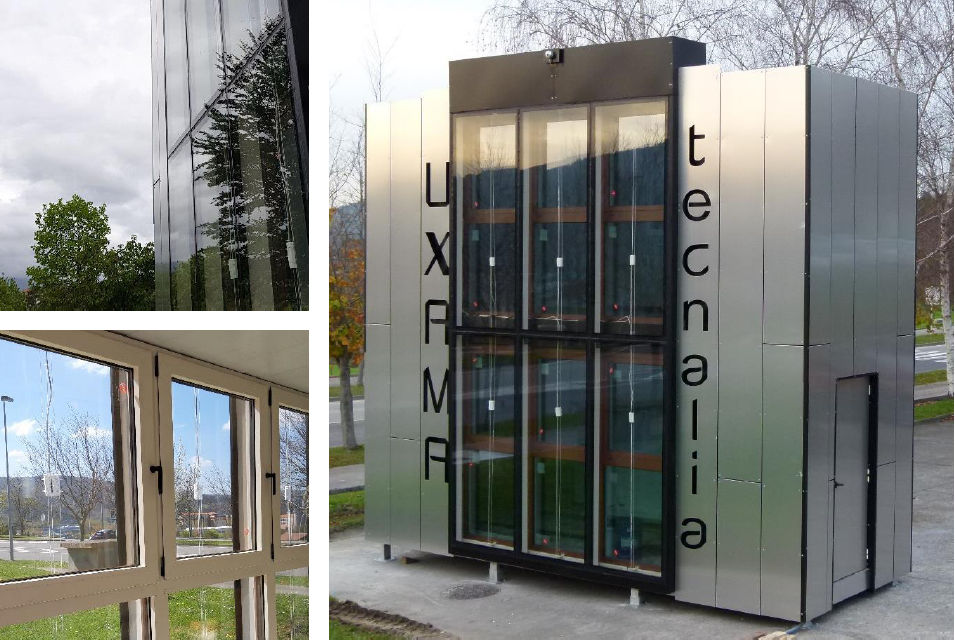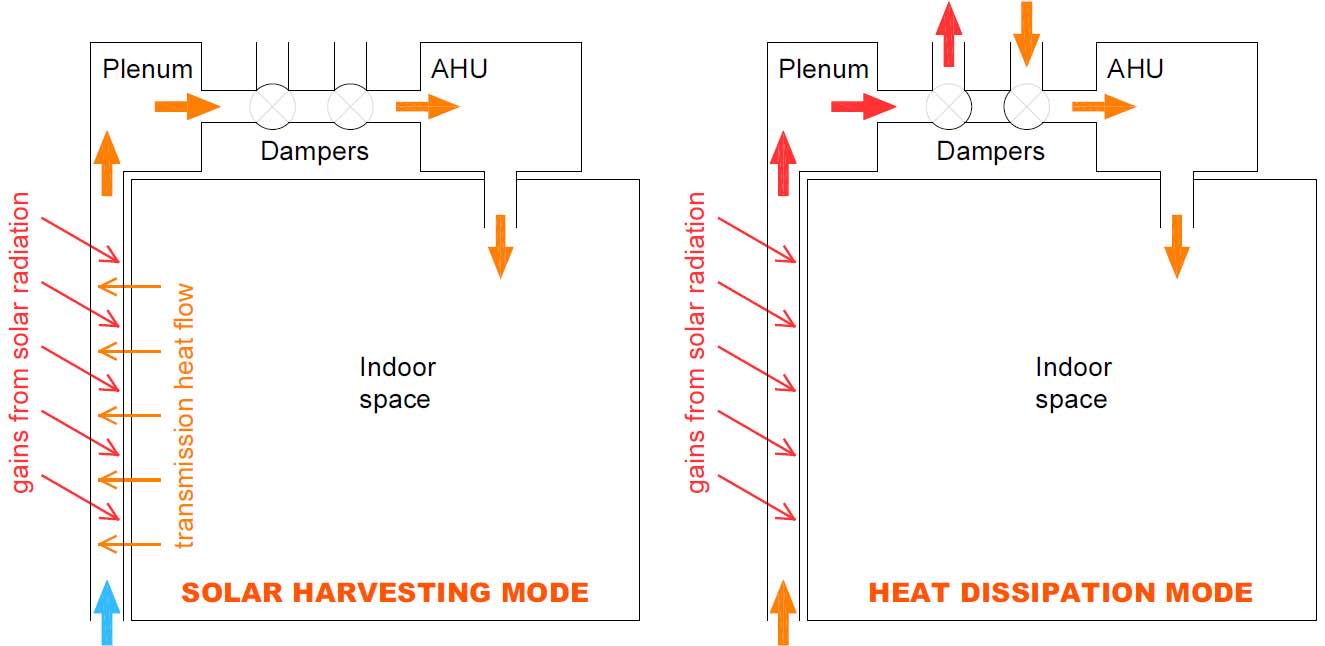Solar Energy Harvesting Systems
Prototype Systems
MC-Solar – Modular Curtain Wall With Air-Driven Solar Collection
By Beñat Arregi and Roberto Garay, Tecnalia, Spain
Product Description
Brief Concept Description
MC-Solar is a modular double-skin curtain wall that harvests solar radiation to preheat fresh air conveyed to the ventilation system of a building. The air cavity between the internal and the external skin enables not only to exploit solar gains but also to recover the heat transmission losses from indoor. The system can supply the airflow required for ventilation with preheated fresh air, thereby reducing the energy consumption during the heating season, and even delivering net gains in favourable conditions. In cold weathers, the system aims to partially or fully cover the heat demand of the building with free solar heat gains. Whenever heating is not needed, a bypass element allows the evacuation of the excess heat by stack effect so that the façade operates as rear-ventilated façade system.
MC-Solar has been jointly developed by Uxama Fachadas Singulares, Enertec and Tecnalia. The main target market is the commercial sector, and in particular the renovation of office buildings. The system is conceived as an energy harvesting alternative to conventional curtain wall systems and can be coupled to any commercial air handling unit.

Figure 38. Full-scale prototype for experimental validation of the concept.
Architectural and Technological Integration into the Envelope
The aesthetic appearance of MC-Solar does not differ from commercial curtain wall façades, and transparency is maximised as no visually obtrusive elements are required.
The layering of the façade is engineered to maximise the share of solar gains emitted to the air cavity between internal and external skin, while minimising the gains to the indoor space. The external glazing is made of an absorptive sheet with a high solar factor, and the internal glazing combines insulating properties with a low solar factor and low reflective properties. The base of the curtain wall accommodates a series of openings with integrated filters for directing clean external air into the cavity. Transoms are narrower than vertical mullions to allow the continuity of the air cavity along the full height of the façade. The rising preheated air is collected into an opaque plenum that is visually integrated in the roof parapet.
Integration into the Building: System and Comfort
A duct from the pre-heated air collection plenum provides an alternative supply to the air handing unit (AHU), thereby allowing a simple integration with the centralized mechanical ventilation system of the building. An integrated control system with embedded sensors and actuators operates a series of dampers, which can either direct the preheated air to the inlet of the AHU (powered by a ventilator) or dissipate it to the environment. Hence the heating and cooling loads of the building are reduced, and ventilation air is supplied close to comfort temperatures. The system allows for an immediate use of solar gains and does not require a connection with hydraulic circuits nor the use of additional products or materials with thermal storage capabilities.

Figure 39. Diagram of the concept and operation modes of MC-Solar and its integration with the ventilation system.
SWOT Analysis
Strengths
- Aesthetic qualities of curtain walls are kept (transparency, visual contact with exterior)
- It reduces energy demand by covering a share of the heat load with solar energy
- It is a fully modular and prefabricated solution adaptable to specific design choices
- Easy integration with centralised ventilation systems: no storage or hydraulic circuit
- It improves both comfort and indoor air quality (ventilation rate can increase whenever free solar gains are available)
- The additional cost over conventional curtain wall façades is low
Weaknesses
- The choice of glazing systems is constrained if an optimum energy performance is sought
- It requires connection with an air handling unit (might not be suitable for all buildings)
- Not yet evidence on long-term durability and maintenance of filtering systems
Opportunity
- It sits well within the strong market trend towards modular curtain walls
- It can satisfy (often conflicting) energy efficiency and indoor air quality requirements
- Future changes in regulation with more strict requirements will provide a strong advantage against conventional curtain wall systems
Threats
- Regulations for commercial buildings still have poor energy performance requirements
- Market and regulations are still focused on add-on renewables, little awareness on envelope-integrated renewable systems
- Other renewable technologies (as PV) could get more cost-competitive in the mid-, longterm
- Awareness of energy efficiency in the curtain wall market is growing but it is still limited
Lessons Learned
- Building the solution over already existing products (e.g. curtain wall framing, parapet elements) leads to lower added costs and a more successful aesthetic integration.
- Hygrothermal conditions in the air cavity might differ from regular double-skin walls: potential implications need to be considered at design stage.
- Coordination between construction and ventilation professionals is key for achieving an efficient implementation.
Further Reading
González, D., Arregi, B., Garay, R., Álvarez, I., Sagarduy, G. Innovative curtain wall with solar preheating of ventilation air and integrated control system. ICAE 2018, San Sebastian, Spain.
Acknowledgment
This project has received financial support from the Basque Government through the Hazitek programme (project ref. ZL-2016/00720, ZL-2017/00571, ZL-2018/00201), supporting experimental development and industrial research projects.